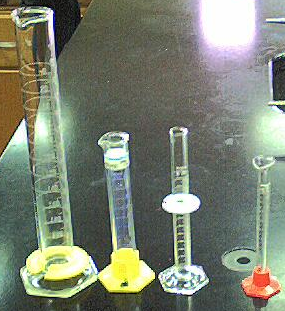Introduction
This note pack will show you how to read a scale to the appropriate precision. One major application of this skill in the chemistry lab is the use of graduated cylinders. Graduated cylinders are cylindrical containers which feature a pour spout and a printed scale which will tell you the volume of the liquid either contained inside or delivered by the cylinder. The graduated cylinder is the most common device used in the chemistry lab to measure the volume of liquids.
The graduated cylinder
Graduated cylinders come in many sizes. A few of them are pictured below.
| Illustration 1 – Graduated cylinders |
The picture shows four different cylinder sizes. There are larger and smaller cylinders for measuring much larger and much smaller volumes of liquid. You will typically use 100 mL, 25 mL, and 10 mL graduated cylinders in your lab work – depending on how much liquid you need to measure.
These cylinders all have something in common, aside from their general shape. They have a scale, which looks and works much like a ruler does. Reading a graduated cylinder is little different than reading a ruler.
Reading a graduated cylinder
To read a graduated cylinder, you must know a few things:
- How to interpret the scale.
- How to tell what the liquid level is.
- How many decimal places (in other words, to what precision) to read from the scale.
We will discuss all three of these points. First, how do you interpret the scale? Let’s do an example. Here is a typical 10 mL graduated cylinder.
Now, how do you read the scale? The liquid has a curved surface (called a meniscus). This is due to water’s interaction with both itself and the glass surface of the cylinder. By convention – which means that everyone who makes graduated cylinders designs them this way – you read the liquid level at the bottom of the curved surface (meniscus). In the cylinder in Illustration 2, the meniscus is somewhere between 1.5 and 1.6 mL.
To how many decimal places do you read the cylinder? When you take any measurement in the lab, you’re supposed to record all digits that you’re certain of, plus one digit that is your “best guess” – or estimate – of the next decimal place. In the example cylinder, you are certain that the volume of the liquid is at least 1.5 mL, but less than 1.6 mL. So, you estimate the last decimal place, and read the cylinder as 1.54 mL.
You may guess the last digit differently than I did. 1.53 mL and 1.55 mL, for example, are equally acceptable readings. After all, the last digit is uncertain!
(What if the meniscus appears to be exactly on one of the lines? For example, what if the meniscus in Illustration 2 appeared to be exactly on the 1.5 mL line? Then read the cylinder as 1.50 mL)
For larger and smaller cylinders (or even for just more expensive and cheaper models of the same size cylinder), you may read to a different decimal place. The decimal place you read to should be one place after what’s directly indicated on the scale. For this 10 mL cylinder, the scale indicates volumes to the nearest 0.1 mL, so we read the scale to the nearest 0.01 mL. Here is a table of some common cylinder sizes and the decimal place you read them to:
| Cylinder type | Smallest lines represent | So you read to | An example reading |
|---|---|---|---|
| 10 mL | 0.1 mL | 0.01 mL | 1.54 mL |
| 25 mL (cheap) | 1 mL | 0.1 mL | 14.6 mL |
| 25 mL (better) | 0.1 mL | 0.01 mL | 14.63 mL |
| 50 mL | 1 mL | 0.1 mL | 37.5 mL |
| 100 mL | 1 mL | 0.1 mL | 90.0 mL |
To contain vs. to deliver
Some graduated cylinders are printed with the letters “TC”, while others are printed with “TD”. “TC” means “to contain”. A “TC” cylinder’s scale is meant to measure the amount of liquid inside the cylinder. If you measure 10.0 mL of liquid in side a “TC” cylinder and then pour it out, you will actually pour out a little less than 10.0 mL. Some amount of liquid will remain behind in the cylinder.
“TD” means “to deliver”. A “TD” scale measures the amount actually dispensed by the cylinder, and it accounts for the liquid left clinging to the glass after pouring.
“TC” and “TD” scales are used on many types of chemical glassware, not just graduated cylinders!
The future
These guidelines are not just for graduated cylinders – they’re for any scale. You may use (in later courses) a device called a buret, which is essentially a very tall graduated cylinder with a valve at the end. It’s read the same way as a cylinder. Mohr pipets, which are pipets with a printed scale on the side, are also read the same way. So is a regular metric ruler.
Summary
In this note pack, you’ve learned a little bit about graduated cylinders – that they come in many sizes and with several different scales. You should now be able to look at a graduated cylinder and figure our (without anything but your brain and your eyes), how to determine what each line on the scale represents. You should also be able to read a graduated cylinder to the correct decimal place.


